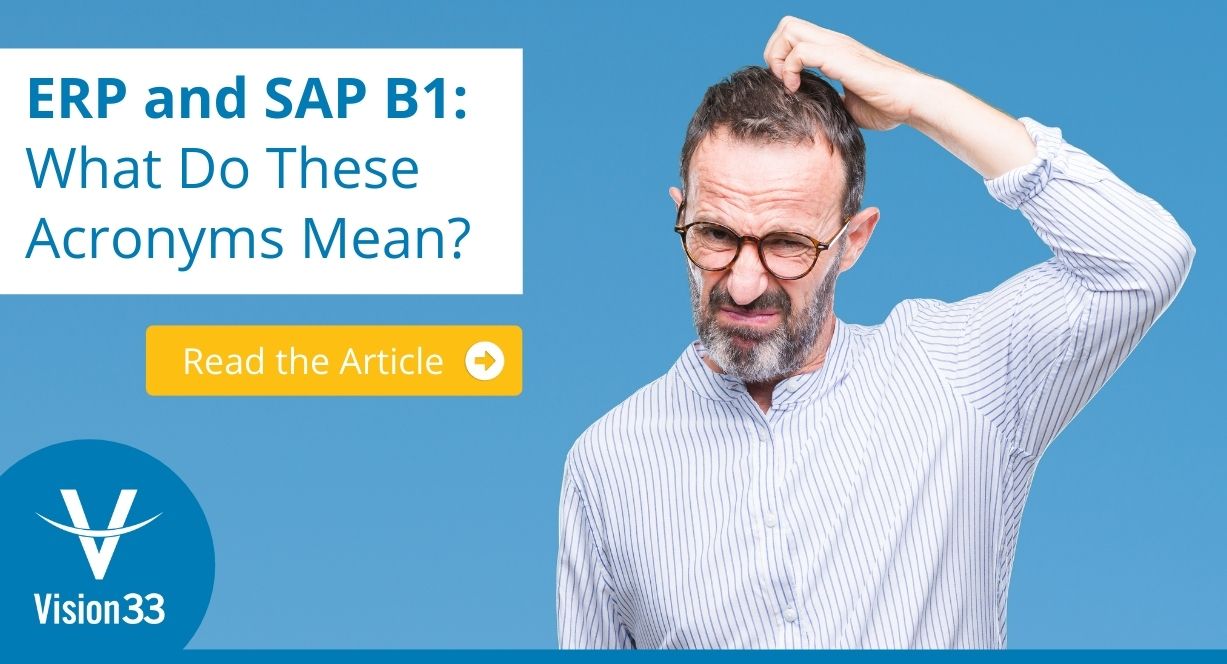FortPro Paves the Road to Success With Vision33’s Customer Portal for SAP B1
SAP Business OneWith Vision33's Customer Portal, FortPro’s salespeople can focus on higher-value tasks like...

December 03, 2019
Blog > ERP and SAP B1: What Do These Acronyms Mean?
Enterprise technology is a robust category of business management software. Its rich functionality offers businesses an integrated application that collects data from all business areas into one system for easy reporting and decision-making. Enterprise technology’s powerful features, sophistication, and seamless integration with other applications has necessitated the use of acronyms to more efficiently describe a business's ecosystem of enterprise applications and their functionality.
These acronyms can leave businesses that are new to these technologies in the dark. In this blog we shed light on three of the most common acronyms used in enterprise technology: ERP, SAP, and SAP B1.
ERP is an acronym that stands for enterprise resource planning. ERP solutions are a category of business management software that enable you to connect the core functions of your business - including accounting, manufacturing, and finance - to your supply chain. With a connected system, you can share information across all departments and with your vendors and customers. From a worker in production to the owner of the company, ERP software provides employees visibility into all aspects of your operation by centralizing your databases into a single location.
But it’s just as important to understand what ERP is not. Accounting software such as QuickBooks doesn’t fit the criteria of an ERP. ERP software represents the next logical step up from accounting software.
Let’s start with the pronunciation of SAP. The correct pronunciation is saying each letter individually: S-A-P, although you may find differences based on your location. SAP is the name of a German multinational software company. The company was founded in 1972 by five German engineers who worked for IBM in Mannheim, Germany. The company took the name SAP from the abbreviation for Systemanalyse und Programmenentwicklung (systems analysis and program development in German).
In the 1970s, SAP struggled to sell the concept of an integrated software product that could be adapted to run any company’s processes. By the 1990s, however, SAP had grown to the business software applications vendor of choice for nine of the ten largest U.S. corporations, one-third of the Fortune 500, seven of the ten largest Business Week Global 1000, and 80% of the Fortune 100 companies in software, computers, peripherals, and semiconductors.
In 2001, SAP made the acquisition that would trigger its entry into the small business space with a simple yet robust product. It purchased TopTier Software, an Israeli company specializing in portals, along with its sister company TopManage, which developed small business software.
After the acquisition, TopManage’s product became SAP Business One and was introduced to the U.S. market in 2003. Although the official name of SAP’s flagship solution for the midmarket is SAP Business One, it is often abbreviated as SAP B1, or simply B1. SAP ERP software is purpose-built for SMEs.
Since the release of the product in 2003, SAP Business One has undergone eleven significant version releases, resulting in a product that can be deployed/implemented in a timeframe and at a cost reasonable for small and growing businesses. To learn more about making the shift from accounting software to ERP, access Vision33's Beginner's Guide to ERP.
For fast-growing businesses, the time to shift from small business accounting software (e.g. QuickBooks) to an ERP platform may already be upon you. But how do you know for sure and where do you begin sorting through your options?
These are challenging and often complicated questions to answer, and in most cases, the available resources online don’t clarify anything. For that reason, we consolidated all our early stage ERP resources in one place.
Subscribe to our newsletter to receive our latest blog posts, case studies and ERP news delivered straight to your inbox.
With Vision33's Customer Portal, FortPro’s salespeople can focus on higher-value tasks like...
SAP Business One empowers oil and gas companies to improve resiliency through streamlined...
SAP Business One is an enterprise resource planning (ERP) solution that helps distributors navigate...
Recieve our latest blog posts, case studies, and ERP news
delivered straight to your inbox.